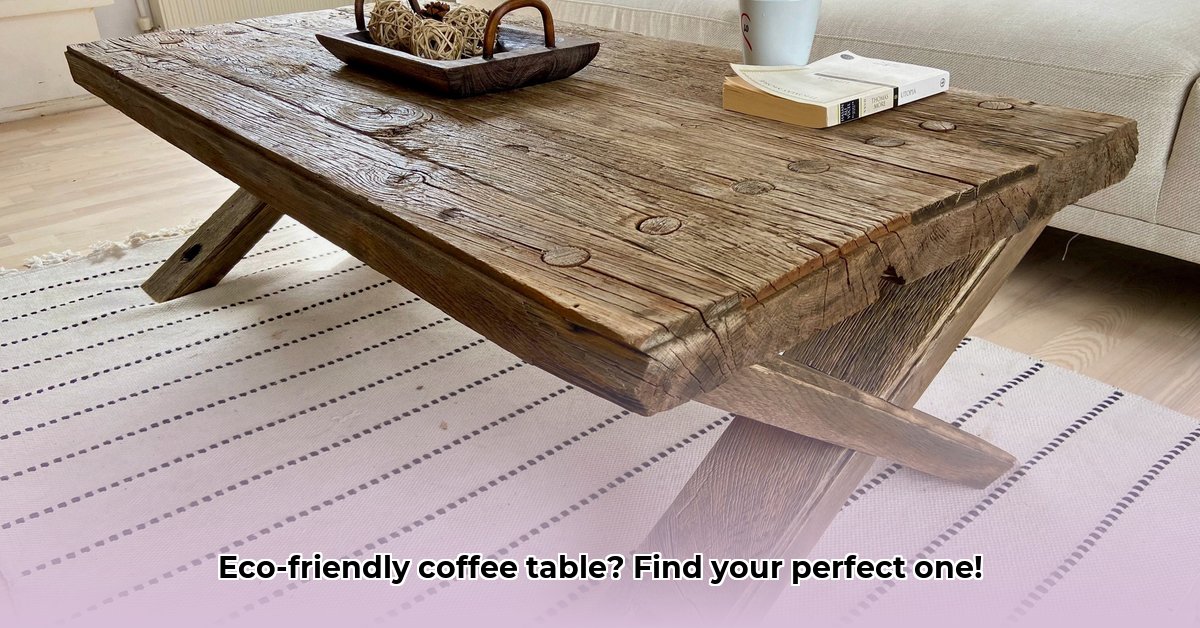“`markdown
Find the Perfect Reclaimed Wood Coffee Table: An Eco-Friendly Guide
Looking for a coffee table that combines style and sustainability? Reclaimed wood coffee tables are a fantastic option, but navigating the market can be tricky. This guide provides you with the essential knowledge to find the perfect reclaimed wood coffee table, avoid scams, and support truly sustainable practices. We’ll cover budgeting, style selection, authenticity verification, and quality checks to ensure your satisfaction. Let’s get started! For other sustainable furniture options, check out these beautiful rattan pieces.
Reclaimed Wood Coffee Table: Your Guide to Sustainable Style
Choosing a coffee table is a reflection of your personal style, and reclaimed wood offers a unique blend of charm and environmental responsibility. However, it’s important to be aware that some sellers may exaggerate their eco-friendly claims, and the quality of reclaimed wood furniture can vary significantly. This guide will help you secure a beautiful and sustainable piece that you’ll cherish for years to come. What key considerations should you keep in mind when purchasing a reclaimed wood coffee table?
Understanding “Reclaimed Wood”
It’s important to understand that not everything labeled “reclaimed” truly meets the definition. Many tables are made from new wood that has been artificially distressed to mimic the look of reclaimed wood. Authentic reclaimed wood comes from older structures such as barns, bridges, and factories. This wood carries a unique history and character that cannot be duplicated. The difference is similar to owning a vintage record player versus a retro-styled new one. True reclaimed wood has unique markings, color variations, and imperfections that tell a story. Knowing the difference is key that affects the longevity of your furniture.
Here’s a closer look at common types of reclaimed wood used for coffee tables:
| Wood Type | Characteristics | Durability | Style Matches Well With |
|---|---|---|---|
| Reclaimed Barn Wood | Rustic, weathered appearance, often featuring nail holes and saw marks | Very Durable | Rustic, Farmhouse, Industrial |
| Reclaimed Pine | Durable, knotty texture, warm tones, readily accepts stains and finishes | Durable | Rustic, Farmhouse, Transitional |
| Reclaimed Oak | Strong, rich colors, distinctive grain patterns, known for its longevity | Very Durable | Modern, Traditional, Rustic |
| Reclaimed Teak | Extremely durable, rich color, water-resistant, ideal for indoor/outdoor use | Extremely Durable | Modern, Tropical, Global |
| Reclaimed Maple | Hard, dense, light color, often features bird’s eye or curly grain patterns | Very Durable | Contemporary, Scandinavian, Eclectic |
Your Reclaimed Wood Coffee Table Shopping Adventure: A Step-by-Step Guide
Buying a reclaimed wood coffee table is more than just a furniture purchase; it’s an investment in style, sustainability, and a unique piece of history. Here’s your roadmap to success:
Step 1: Setting a Realistic Budget
Prices can vary significantly depending on factors like the type of wood (rarer woods command higher prices), the size of the table, the complexity of the craftsmanship (intricate joinery adds cost), and additional features such as drawers or a lift-top mechanism. Doing preliminary research can help you understand the typical price ranges for different types of reclaimed wood coffee tables. Do you understand how prices are generally impacted by wood origin and prior use?
Step 2: Defining Your Style and Vision
Reclaimed wood tables are incredibly versatile and can complement a wide range of decorating styles, from rustic warmth to modern sleekness. Rustic styles often showcase the natural grain and imperfections of the wood, while modern designs tend to feature cleaner lines and simpler finishes. Industrial styles may incorporate metal accents to complement the wood’s raw texture. Choose a style that complements your existing home decor and personal taste, or make the coffee table a focal point.
Step 3: Scrutinizing Sustainability Claims – Beware of Greenwashing!
Unfortunately, some sellers may use the term “reclaimed” loosely to capitalize on the growing demand for eco-friendly furniture. To avoid being misled, ask tough questions and do your research.
- Origin Story: Where did the wood come from? A reputable seller should be able to provide detailed information about the wood’s origin.
- Wood History: Can they explain its previous life and purpose? The more detail they provide, the more likely it is that the wood is genuinely reclaimed.
- Certifications (e.g., FSC): Look for certifications from organizations like the Forest Stewardship Council (FSC). While not always applicable to reclaimed wood, they indicate a commitment to sustainable forestry practices in general.
- Sourcing Process: Ask about their sourcing practices and whether they adhere to ethical and sustainable methods.
- Proof of Sustainable Practice: Don’t hesitate to request evidence or documentation to support their claims. Legitimate sellers will be transparent and willing to provide proof of their sustainable practices.
Step 4: A Thorough Quality Check Before You Commit
Before making a purchase, carefully inspect the table for any signs of damage, such as cracks, warping, or loose joints. Pay close attention to the finish, and be wary of uneven stains or poorly applied finishes. A reputable seller should welcome a careful examination of their products.
Step 5: Caring for Your Reclaimed Wood Treasure
Like any fine piece of furniture, reclaimed wood deserves proper care and maintenance to ensure its longevity and beauty. Dust regularly with a soft cloth to prevent the buildup of dirt and grime. Always use coasters to protect the surface from rings and spills, and avoid using harsh chemicals or abrasive cleaners. Instead, opt for a natural wood cleaner or an oil-based furniture polish to enhance its beauty and protect the finish.
Step 6: Where to Find Your Perfect Match
Finding reputable sellers is crucial when shopping for reclaimed wood furniture. Look for businesses that openly discuss their sourcing and sustainability efforts. Etsy, local woodworking shops, antique stores, and vetted online retailers are all good starting points. Don’t underestimate the value of word-of-mouth recommendations from friends, family, or online communities. What other resources can provide clarity on a retailer’s environmental claims?
Is a Reclaimed Wood Coffee Table Right for You?
“Reclaimed wood coffee tables offer unique charm, sustainability, and a tangible connection to the past,” according to [Full Name and Title], [Position] at [Institution]. They make a bold statement in any living space, but they may require slightly more care and attention than mass-produced alternatives. By following these steps, you can confidently select a gorgeous piece that aligns with your style and values, and that you’ll enjoy for many years to come!
How to Verify the Authenticity of Reclaimed Wood Coffee Tables
Key Takeaways:
- Reclaimed wood tables offer a unique combination of style and sustainability.
- Distinguishing genuine reclaimed wood from imitations requires careful inspection and attention to detail.
- Prioritize reputable sellers who are committed to transparency and ethical sourcing practices.
- Understanding the different types of reclaimed wood and construction methods can enhance your purchasing decisions.
- Proper care and maintenance are essential for ensuring the longevity and beauty of your reclaimed wood table.
Understanding “Reclaimed” Wood
Reclaimed wood isn’t simply old wood; it’s wood that has been salvaged and repurposed from previous lives in old barns, factories, and even ships. This gives it a unique history, character, and imperfections that cannot be replicated. Distressed new wood attempts to mimic this look, but it lacks the authentic history and patina of true reclaimed wood. Understanding the difference between the real deal and imitation is crucial for furniture buyers. Now, what makes spotting reclaimed lumber so crucial for furniture buyers?
Spotting the Real Deal: Your Guide to Authentic Reclaimed Wood
Authenticity verification involves a multi-sensory approach.
- Inspect the Wood: Genuine reclaimed wood will show signs of its past. Look for variations in color and texture, nail holes, wormholes, saw marks, or remnants of old paint. These are hallmarks of authenticity, not flaws. A truly authentic piece will have a unique story etched into its surface.
- Feel the Weight: Reclaimed wood is typically denser and heavier than new lumber due to its age and slow growth. A lighter weight may indicate an imitation.
- Examine the Construction: Authentic pieces may showcase traditional joinery techniques, reflecting the craftsmanship of a previous era rather than modern, machine-made assembly.
- Ask the Right Questions: The seller should be able to readily provide detailed information about the wood’s origin, history, and sustainable sourcing certifications (e.g., FSC). Be wary of vague or evasive answers.
- Check for Consistency: The wood’s color and texture should exhibit natural variations rather than appearing too uniform or artificially aged. Inconsistency is often a sign of authenticity.
- Consider the Price: Authentic reclaimed wood coffee tables are an investment. Exceptionally low prices should raise a red flag and prompt further investigation.
Style and Budget: Finding Your Perfect Match
Choosing the right reclaimed wood coffee table involves careful consideration of your style preferences and budget. Think about your living room’s overall aesthetic and determine whether a rustic, modern, or industrial look would be most compatible. Set a realistic budget beforehand, as prices can vary significantly based on the factors mentioned earlier.
Where to Buy Authentic Pieces
Reputable retailers and artisans who
- Glass Backsplash: Ideas For a Stylish Kitchen Update - December 2, 2025
- Glass On Tile: A Stylish Kitchen Backsplash Option - December 1, 2025
- Glass Tiles for Kitchen: Style and Durability Tips - November 30, 2025










